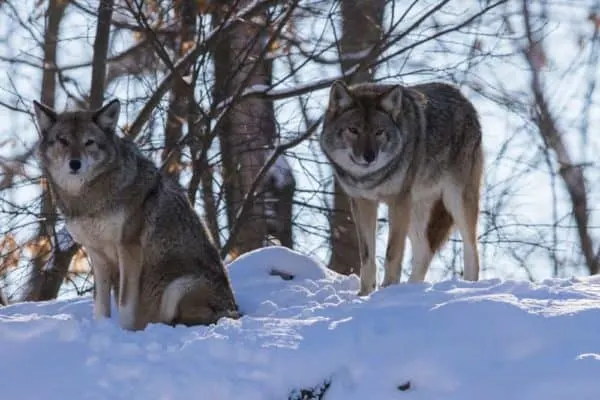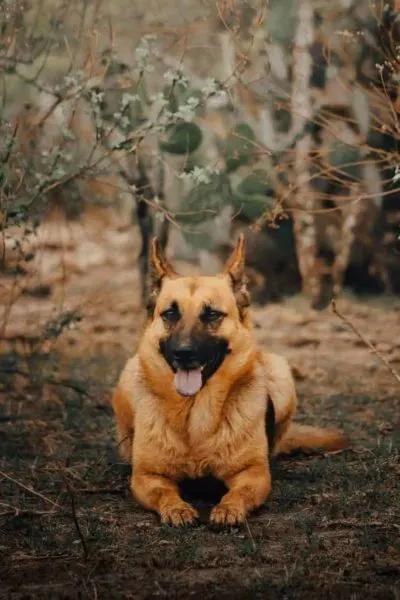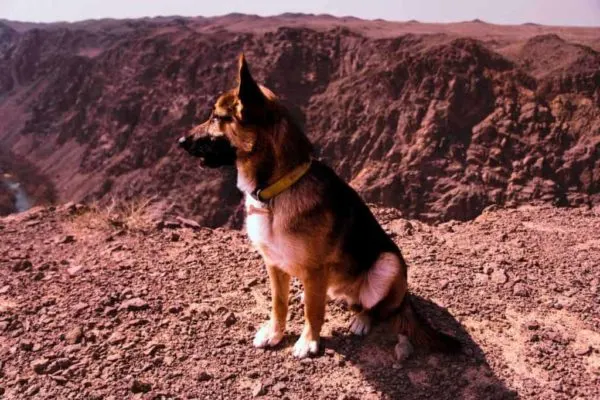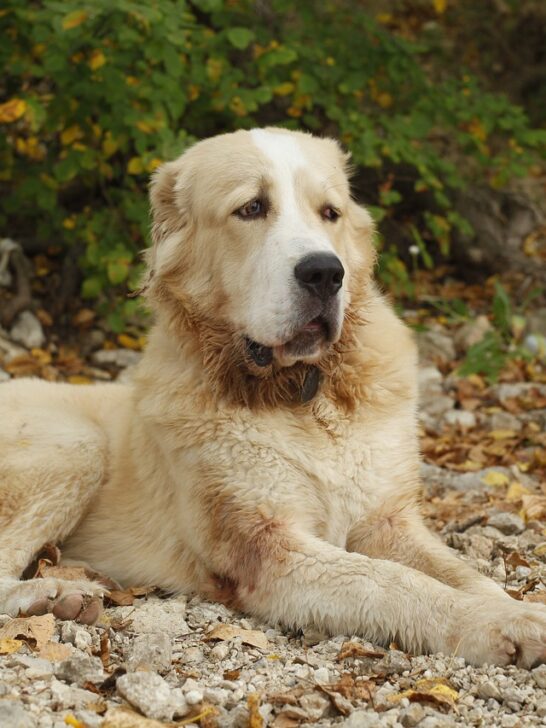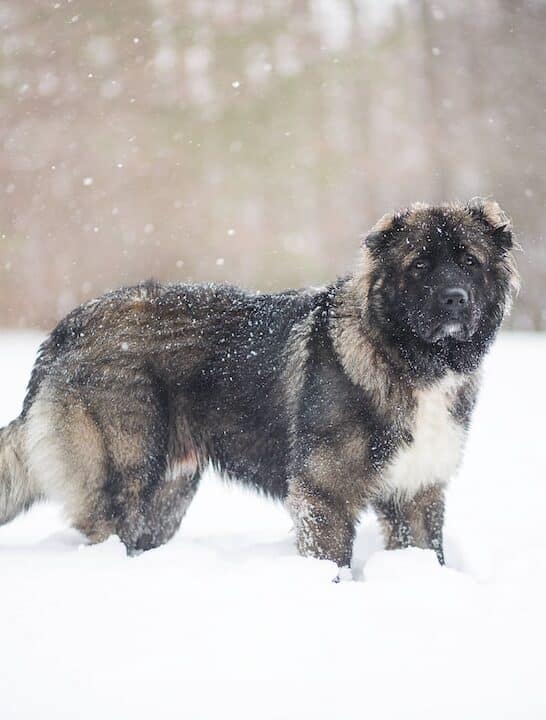German Shepherd vs Coyote: Who wins? 11 Major Differences Worth Knowing
Let’s face it – German Shepherd dogs (GSDs) and coyotes do look a lot alike.
Many German Shepherds have been killed because they were mistaken for coyotes.
If you take the time to really look, that big canine wandering about may just be a lost GSD and not a wild coyote.
GSDs were purposefully bred to resemble a wild dog like a wolf in order to better do their original jobs to protect and guide sheep.
Sheep and other livestock instinctively move away from anything looking like a wolf or coyote. That’s why GSDs have pointed ears and long muzzles.
However, German Shepherd dogs and coyotes differ in size, coloring, leg shape, the tracks they leave, the scat they produce, and how they hold their tails.
They differ in behavior from how they get along with other canines and how they get along with other animals.
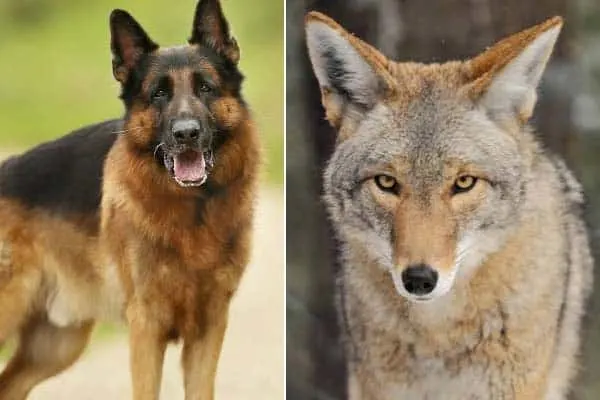
German Shepherd vs Coyote: Differences in Size
GSD males are usually taller and heavier than coyotes, but not many females.
According to the American Kennel Club (AKC), a GSD can range from 22 to 26 inches at the shoulder and tip the scales from 50 to 90 pounds. They look like powerful animals.
Male coyotes are larger and heavier than female coyotes. Both sexes range in height from 21 to 26 inches at the shoulder.
According to the Pennsylvania Game Commission, coyotes weigh anywhere from fifteen to 55 pounds. They look like thin, hungry dogs.
Differences in Color
The most common color in GSDs is black and tan. Fortunately, this color does not appear in coyotes.
It’s when you compare the uncommon colors of GSDs that they get easily confused with coyotes.
Black appears in both species, but coyotes often have a dark grey neck, chin, and belly.
There is one color that GSDs rarely come in that coyotes do not – pure white. Any pure white coyote soon dies, as the color makes it conspicuous to prey.
White GSDs or White Shepherds are not allowed to be shown on most shows in the United States, but still, crop up in purebred litters.
Differences in Their Legs
According to DifferenceBetween, The average GSD sports a deeper and often broader chest than the average coyote, but this is hard to see.
It’s much easier to compare the length and shape of their legs than their chests.
Coyotes look like they sport longer legs than German Shepherds, even though the leg lengths are similar.
German Shepherds in North America often have unusually shaped hind legs.
This makes their hind ends appear in a permanent crouch, with their spines sloped down to the tail.
In comparison, coyote backbones are more level from neck to tail.
Differences in Their Tracks
If you can’t get a good, long look at the animal, you can at least get a good, long look at the pawprints or tracks that the animal leaves behind.
Fortunately, coyotes and GSDs leave very different sets of prints because of how their chests and legs are shaped.
Coyotes’ long legs leave fewer prints to find. The hind paw prints are usually obscure or are partly on top of the forepaw prints.
With a German Shepherd or any other dog, the prints of all four paws are clearly seen, as if they walk a much wider path through life than a coyote.
Differences in Scat
“Scat” is a polite way to say “poop.” Although the poop is similar in shape and color, there are differences.
It may be gross to compare the two, but if you cannot find tracks or have a good view of the animal, scat can help.
Coyote scat is usually thinner (usually less than one inch in diameter) and smaller than GSDs.
Since coyotes eat the hides of their prey, bits of fur or feathers may stick out.
Dogs, due to eating more consistently, tend to have larger and fatter scats. They usually do not contain fur or clumps of hair.
Differences in Tail Shape and Position
If it’s too hard to compare legs, colors, or heads, look at the tails. Both GSDs and coyotes have tails similar in thickness and color.
Coyotes tend to have black tail tips, but not always. German Shepherds tend to have tails more hooked at the end than a coyote’s tail.
More importantly, coyotes keep their tails low when on the move, especially when trotting.
Any dog, including GSDs, tend to lift their tails when they trot or walk.
Dogs will tuck their tails between their legs and run if frightened.
Differences in How They Run
If the canine moves towards you, the chances are high that it’s a dog. Coyotes are wary of people.
You may only get a glimpse of a fast-moving dog-like critter.
Pay attention not only to how the tail is held, but how the backbone moves while the animal is racing away.
According to Wild Aware Utah, coyote backbones stay still when the animal runs. In contrast, a dog’s backbone rocks up and down with every stride.
This often causes the head to bob up and down, as well.
Differences in Vocalizations
Dogs of any breed, including GSDs, are more prone to make vocal noises than a coyote.
Wild animals like coyotes need to be as quiet as possible in order to sneak up on their prey and not get noticed by bigger predators like wolves or people.
Coyotes do make noises. The most common noises are a high yipping, a short bark-like growl and a howl that sounds like a human laughing.
In comparison, GSDs will bark, growl, whine, or woof. They yip only when hurt. They do howl, but not as often as a coyote or a wolf.
Differences in How They React to Other Canines
Coyotes barely tolerate other coyotes, let alone dogs. They are notorious for killing dogs of any size or breed.
They will even go after foxes.
Other dogs are seen as competitors for the coyote’s food. So, coyotes will attack other canines except for wolves.
In contrast, dogs generally love the companionship of other dogs. There may be some snapping or growling, but the GSD is not a fighting dog.
They tend to be very friendly or even try to hide from other dogs their size or larger.
Differences in How They React to Other Animals
Due to their friendly nature, high intelligence, and willingness to please their people, GSDs can be easily trained to get along with other animals.
They were originally bred to protect sheep and not attack sheep, other livestock, or people.
This is not the case with a coyote. Coyotes do not like other animals.
All other animals are either to eat, to kill so they do not compete for the coyote’s game or to be run away from as quickly as possible.
Differences in Collars or Ear Tags
If you are fortunate, the canine you see will wear a collar or ear tags.
If the stray canine you spot has a neck collar with metal tags dangling from it or if nothing is dangling from it, chances are it is an escaped pet German Shepherd.
Coyotes sometimes wear neck collars, but they do not sport little metal tags. Attached to the collars are often clunky rectangles.
This particular coyote has been tagged and is being tracked by scientists. The coyote may also have a plastic ear tag, which a dog won’t have.
Warning About Strange Animals
Despite their differences, a strange German Shepherd or coyote are the same in one respect – you should never try to touch them.
Even an escaped pet GSD may be terrified at being lost and may bite out of fear and not viciousness.
Coyotes will bite and scratch to get away from you.
If you are unsure about the species of any canine you see in your neighborhood, call the police or animal control. Let them deal with it.
Even a pet dog can cause considerable harm to you if it is scared enough. Diseases like rabies can be transmitted through dog or coyote bites.
German Shepherd vs Coyote: The Big Differences
Although they share a lot of physical similarities, GSDs and coyotes differ largely in certain physical characteristics, vocalizations, and behavior.
GSDs are usually larger, seem to have shorter legs, deeper chests, poop more, and are friendly with other animals and people.
In contrast, coyotes prefer being by themselves. They are quieter and keep their tails down more often.
They attack other canines and animals.
They prefer to run away from people rather than attack.
Now that you know the big differences between German Shepherds and Coyotes, have you ever wondered about the coyote German Shepherd mix?
FAQ:
1. What are the differences between German Shepherd dogs (GSDs) and coyotes?
Answer: German Shepherds and coyotes differ in size, coloring, leg shape, tracks, scat, vocalizations and behavior. While GSDs are usually larger, with shorter legs and deeper chests, coyotes tend to have longer legs and a thinner frame. GSDs also tend to be friendly with other animals and people, while coyotes mainly prefer to be alone and attack other canines and animals.
Answer: Yes, GSDs and coyotes do share some physical similarities, such as the thickness and color of their tails. They also have pointed ears and long muzzles, which are common features for wild dogs like wolves and coyotes.
3. Why do GSDs have pointed ears and long muzzles?
Answer: GSDs were purposefully bred to resemble a wild dog like a wolf in order to better do their original jobs to protect and guide sheep. Sheep and other livestock instinctively move away from anything looking like a wolf or coyote.
4. Are GSDs often mistaken for coyotes, and why?
Answer: Yes, many GSDs have been killed because they were mistaken for coyotes. This is because the two species look quite similar, especially from a distance, and coyotes are known to attack and kill other canines.
5. What should you do if you spot a strange German Shepherd or coyote in your neighborhood?
Answer: If you are unsure about the species of any canine you see in your neighborhood, it is recommended that you call the police or animal control. Even a pet dog can cause considerable harm to you if it is scared enough, and diseases like rabies can be transmitted through dog or coyote bites.














